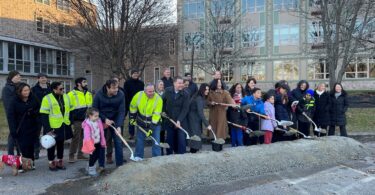by Jeffrey A. Zapfe
While transportation systems are the arteries and veins of a city, when it comes to new development, their presence can cause a developer’s heart to skip a beat. Air rights construction invariably places new facilities in close proximity to highways and/or rail lines, both of which produce noise and vibration that may adversely impact building occupants and sensitive equipment. Fortunately, there are ways to evaluate the potential impacts and mitigate them if necessary.
What is the Concern? Anyone who has dined in a quiet restaurant near a subway line has experienced ground-borne noise. That low-frequency rumble you hear when a train passes by is actually related to the vibration produced by the train. If the vibration is sufficiently severe you might feel it, but more likely you will hear it. The vibrating walls, floor, and ceiling of the restaurant radiate sound like giant loudspeakers. Because the vibration and noise are transmitted through the ground, they are referred to as ground-borne vibration and ground-borne noise.
Sources. Vibrations arriving from outside the building site are known as “environmental vibrations,” and all sources are certainly not created equal. Generally, the order of concern is: 1) freight or commuter rail with diesel locomotives; 2) electric rail, subway, or light-rail transit; and 3) highway or street traffic. Vibrations from street traffic are strongly related to road condition (potholes and other discontinuities can produce significant vibrations), but fortunately, in most cities, these are only temporary.
One challenging aspect of environmental vibrations is that the developer usually has no control over them. Agencies may be willing to work with a developer to reduce vibrations, but most often the onus is on the developer to deal with the impacts.
When Should a Developer be Concerned? Vibrations are site-specific; there are no hard and fast rules for how close is too close. As a rough rule of thumb, a developer should be concerned within 300 feet of a rail line or 100 feet of a street or highway.
Assessing the Impact. Once the building footprint is established, the site vibrations can be measured to determine how much vibration will enter the building and how it will propagate up through the building structure. (Vibration dissipates with distance, so a problem on the first floor might not be an issue on the 10th.) Once the vibrations are known, it is possible to predict the radiated noise, and the potential impact can be assessed. Impact on people is the most common concern, but sensitive equipment in labs or medical facilities may also be an issue.
What About Mitigation? If mitigation is needed, one should first consider the source. You might not be successful, but it never hurts to ask!
Otherwise, the developer is left with solutions that can be applied at the building itself. Since vibrations and noise decrease with increased distance from the source, it might be possible to locate sensitive occupants farthest away from the vibration source — parking and retail on the lowest levels with office and residential on upper floors.
Vibration isolation can also be used to help protect the building. At the foundation level, resilient pads can be used to support the building. Essentially, the building or its columns rest on rubber or similarly resilient pads. At the room scale, elements like floated floors and resiliently hung ceilings and walls can be used to mitigate vibration and noise. Neither of these solutions is trivial, and both introduce complexities into the building design. For sensitive equipment, vibration issues can often be addressed after the fact with local vibration isolation systems.
Knowing how much environmental vibration to expect is clearly important, both to determine whether a project is feasible and, if it is, to mitigate the expected impacts as early and as cost-effectively as possible. Early analysis gives developers and designers the information they need to make informed decisions about these issues.
Jeffrey A. Zapfe, PhD, is president at Acentech.

Jeff Zapfe










